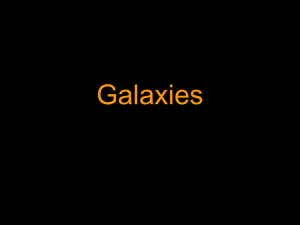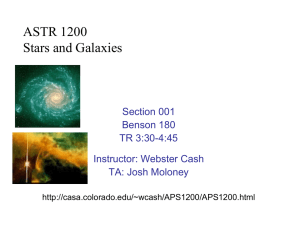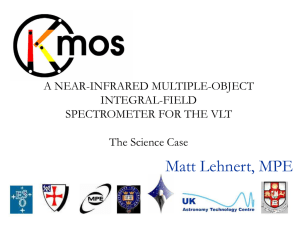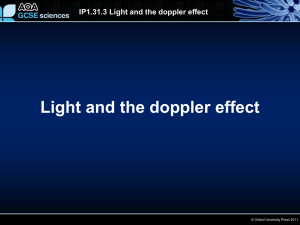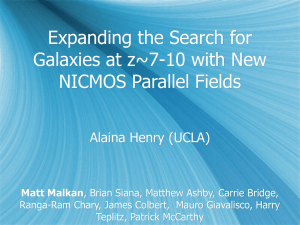i`- z`
advertisement
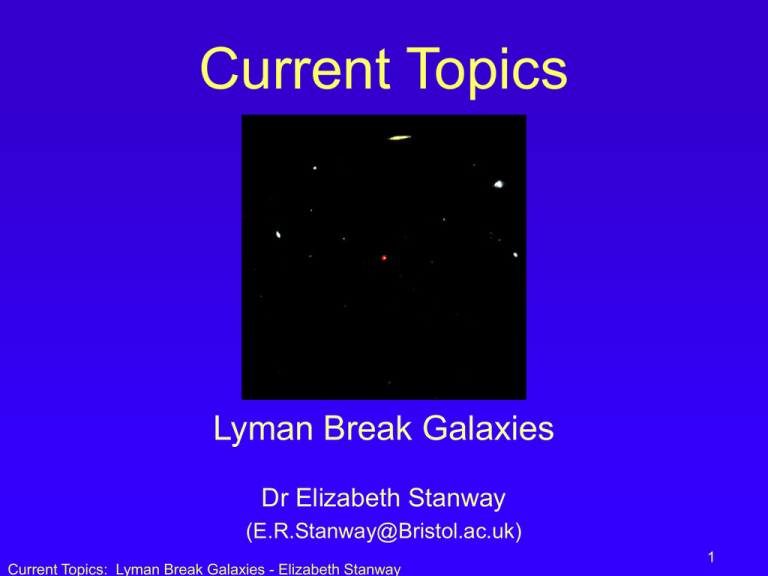
Current Topics Lyman Break Galaxies Dr Elizabeth Stanway (E.R.Stanway@Bristol.ac.uk) Current Topics: Lyman Break Galaxies - Elizabeth Stanway 1 Topic Summary • Star Forming Galaxies and the Lyman- Line • Lyman Break Galaxies at z<4 • Lyman Break Galaxies at z>4 • The Star Formation History of the Universe and Reionisation • This course will be assessed through a 1 hour examination including mathematical and essay questions Current Topics: Lyman Break Galaxies - Elizabeth Stanway 2 Recommended Reading • Steidel, Pettini & Hamilton, 1995, AJ, 110, 2519 • Carilli & Blain, 2002, ApJ, 569, 605 • Verma et al, 2007, MNRAS, 377, 1024 • Bouwens et al, 2007, ApJ, 670, 928 • Stanway et al, 2008, ApJ, 687, L1 Current Topics: Lyman Break Galaxies - Elizabeth Stanway 3 A few definitions … • In these lectures – LBG = Lyman Break Galaxy – LAE = Lyman Alpha Emitter – HST = Hubble Space Telescope – Gyr = 1 Billion Years (Myr = 1 million yrs) – z = redshift – Z = metallicity – z’ or zAB are broadband filters Current Topics: Lyman Break Galaxies - Elizabeth Stanway 4 The History of High-z studies Current Topics: Lyman Break Galaxies - Elizabeth Stanway 5 The History of High-z studies The highest redshift galaxy has been increasing steadily in distance for ~20 yrs Current Topics: Lyman Break Galaxies - Elizabeth Stanway 6 The History of High-z studies Universe 1Gyr old Universe 1/8 current age Universe 1/4 current age Universe half current age Now: Universe 13.7 Gyr Current Topics: Lyman Break Galaxies - Elizabeth Stanway 7 The History of High-z studies z=3 LBGs Universe 1/8 current age ~ 2 Billion years after the Big Bang Current Topics: Lyman Break Galaxies - Elizabeth Stanway 8 Why Push So Far Back? • We are now starting to probe the last major phase transition in the universe - reionisation • We’re within a few generations of the earliest galaxies forming • Unevolved galaxies are simpler - easier to understand - and so help shape theory Current Topics: Lyman Break Galaxies - Elizabeth Stanway 9 Why Push So Far Back? • Lyman break galaxies are star-forming so directly measure how exciting a place the universe is • Lyman break galaxies are relatively bright and so easy to study • Lyman break galaxies are relatively easy to find Current Topics: Lyman Break Galaxies - Elizabeth Stanway 10 But Why is it so difficult? • Redshift equation: • The night sky is also very red => the sky background is much higher for high-z galaxies Flux (obs)=em) * (1+z) => Distant galaxies are very RED Current Topics: Lyman Break Galaxies - Elizabeth Stanway Wavelength 11 But Why is it so difficult? • Distance Modulus equation: m = M - 5 log (dL/10pc) • Luminosity Distance equation: dL = (1+z) * c/H0 * z 0 dz ' m (1 z' ) k (1 z ' ) 3 2 • At z=1, dL=6634 Mpc • At z=3, dL=25840 Mpc • At z=5, dL=47590 Mpc => Distant galaxies are very FAINT Current Topics: Lyman Break Galaxies - Elizabeth Stanway 12 Depth vs Area? • The Luminosity Function (LF) of a galaxy population relates number of objects seen to volume/area observed • Most galaxies follow a Schecter (1973) function: N(L) dA (L/L*)e-(L/L*) dA • When L<<L*, this approximates a power law: N(L) dA LdA => Increasing area of observation leads to increase in galaxy sample BUT: since the power law is steep, increasing the depth usually increase sample size more quickly Current Topics: Lyman Break Galaxies - Elizabeth Stanway 13 Building a Galaxy • Every galaxy is made of stars • Lower mass stars live longer • More massive stars are more luminous => burn more quickly TMS~10Gyr*(M/M) M -2.5 Blue Current Topics: Lyman Break Galaxies - Elizabeth Stanway Red 14 Building a Galaxy • TMS~10Gyr*(M/M) 30 Myr -2.5 300 Myr • Old galaxies are dominated by A-M stars and have 4000A breaks • Young galaxies are dominated by short-lived O and B stars and are UV-bright 10 Gyr 15 Gyr Blue Current Topics: Lyman Break Galaxies - Elizabeth Stanway Red 15 Types of Galaxy SED Old/Red • Old galaxies are dominated by A-M stars and have 4000Å breaks • Young galaxies are dominated by shortlived O and B stars and are UV-bright • Younger galaxies also show strong emission lines, powered by star formation. Current Topics: Lyman Break Galaxies - Elizabeth Stanway Young/ Blue Rest-UV 16 Hydrogen Emission Lines • Flux from star formation excites electrons in atoms • The most abundant atom in the universe is Hydrogen • As an electron relaxes from an excited state, it emits a photon • Each transition emits at a particular wavelength • The easiest transition to excite is Lyman- Current Topics: Lyman Break Galaxies - Elizabeth Stanway The Balmer series emerges in the optical and so is known as ‘Hydrogen-’ etc for historical reasons 17 Hydrogen Emission Lines OIII The Balmer Series and Oxygen lines dominate the optical spectrum of a star forming galaxy OII H H H H •The Lyman series emerges in the ultraviolet. •The Lyman- emission line can emit up to 1% of the galaxy’s bolometric flux, but …. Current Topics: Lyman Break Galaxies - Elizabeth Stanway 18 Hydrogen Emission Lines OIII The Balmer Series and Oxygen lines dominate the optical spectrum of a star forming galaxy OII H H H H •The Lyman series emerges in the ultraviolet. •The Lyman- emission line can emit up to 1% of the galaxy’s bolometric flux, but …. Current Topics: Lyman Break Galaxies - Elizabeth Stanway 19 Hydrogen Emission Lines OIII Ly Å OII H Ly H H H •The Lyman series emerges in the ultraviolet. •The Lyman- emission line can emit up to 1% of the galaxy’s bolometric flux, but …. Current Topics: Lyman Break Galaxies - Elizabeth Stanway 20 The Asymmetric Lyman- Line Low z Higher z The Lyman- line is intrinsicall y symmetric At high-z the line always appears asymmetric and broadened Current Topics: Lyman Break Galaxies - Elizabeth Stanway 21 The Asymmetric Lyman- Line Blue Wing is scattered by outflowing galactic winds Red wing is broadened by back-scattered light Star formation drives galaxy-scale winds (Adelberger et al 2003) Lyman- is resonantly scattered by the winds Wind v=0 v= +300 km/s v= -300 km/s Current Topics: Lyman Break Galaxies - Elizabeth Stanway 22 The Asymmetric Lyman- Line Blue Wing is scattered by outflowing galactic winds Red wing is broadened by back-scattered light v/c = z/(1+z) => 300km/s wind broadens line by about 5Å FWHM at z=3 Wind v=0 v= +300 km/s v= -300 km/s Current Topics: Lyman Break Galaxies - Elizabeth Stanway 23 The Lyman- Forest … Lyman-a is also seen in absorption wherever there are clouds of hydrogen Observer Source z* z=0 Ly Å z*) Current Topics: Lyman Break Galaxies - Elizabeth Stanway 24 The Lyman- Forest … Lyman-a is also seen in absorption wherever there are clouds of hydrogen Observer z=0 Source z1 z* Ly Å z1) Å z*) Current Topics: Lyman Break Galaxies - Elizabeth Stanway 25 The Lyman- Forest … Lyman-a is also seen in absorption wherever there are clouds of hydrogen Observer z=0 Source z4 z3 z2 z1 z* Ly Å z3) Å z4) Current Topics: Lyman Break Galaxies - Elizabeth Stanway Å z1) Å z2) Å z*) 26 The Lyman- Forest At low z almost all of a galaxy’s Lyman continuum flux reaches us Current Topics: Lyman Break Galaxies - Elizabeth Stanway 27 The Lyman- Forest Above z=3, the fraction of galaxy flux reaching us declines rapidly Current Topics: Lyman Break Galaxies - Elizabeth Stanway 28 The Lyman- Forest Beyond z=5.5, <1% of the galaxy’s flux gets through the IGM Current Topics: Lyman Break Galaxies - Elizabeth Stanway 29 The Lyman- Forest Low z Lyman- Forest Current Topics: Lyman Break Galaxies - Elizabeth Stanway Higher z 30 Properties of High-z Galaxies • Young galaxies at high-z are: Current Topics: Lyman Break Galaxies - Elizabeth Stanway 31 Properties of High-z Galaxies • Young galaxies at high-z are: – Dominated by O and B stars Current Topics: Lyman Break Galaxies - Elizabeth Stanway 32 Properties of High-z Galaxies • Young galaxies at high-z are: – Dominated by O and B stars – Bright in the ultraviolet Current Topics: Lyman Break Galaxies - Elizabeth Stanway 33 Properties of High-z Galaxies • Young galaxies at high-z are: – Dominated by O and B stars – Bright in the ultraviolet – Drive strong galactic winds Current Topics: Lyman Break Galaxies - Elizabeth Stanway 34 Properties of High-z Galaxies • Young galaxies at high-z are: – Dominated by O and B stars – Bright in the ultraviolet – Drive strong galactic winds • They have key observable characteristics: Current Topics: Lyman Break Galaxies - Elizabeth Stanway 35 Properties of High-z Galaxies • Young galaxies at high-z are: – Dominated by O and B stars – Bright in the ultraviolet – Drive strong galactic winds • They have key observable characteristics: – They have asymmetric Lyman- emission lines Current Topics: Lyman Break Galaxies - Elizabeth Stanway 36 Properties of High-z Galaxies • Young galaxies at high-z are: – Dominated by O and B stars – Bright in the ultraviolet – Drive strong galactic winds • They have key observable characteristics: – They have asymmetric Lyman- emission lines – Flux is suppressed shortward of Lyman- Current Topics: Lyman Break Galaxies - Elizabeth Stanway 37 Methods of Identifying High z Galaxies Lyman Break Surveys Narrow Band Surveys Gravitational Lensing Surveys • Identifies sources with bright UV continuum emission. • Broad redshift range (typically Δz~0.3-0.5). • Identifies sources with high equivalent widths in certain emission lines. • Narrow redshift range (typically Δz~0.1). • Identifies strongly lensed sources • Often combined with other two methods. • Redshift range variable. Current Topics: Lyman Break Galaxies - Elizabeth Stanway 38 The Lyman Break Technique The Steidel, Pettini & Hamilton (1995) Lyman Break Method • At z=3, about 50% of the Lyman continuum is transmitted • This leads to a ‘break’ in the spectrum • So consider what would happen if you place filters either side of the Lyman- and Lyman limit breaks… Lyman Ionising Continuum Radiation 912Å Break Current Topics: Lyman Break Galaxies - Elizabeth Stanway UV Continuum Lyman-α Break 39 The Lyman Break Technique Red If the filters bracket the breaks, then the galaxies show extreme colours Current Topics: Lyman Break Galaxies - Elizabeth Stanway Blue Red 40 The Dropout Technique ● ● At z>4, the Lyman forest absorption reaches near 100% only one break is detected Starburst at z=6 f-0 A source will be detected in filters above the break but ‘drop-out’ of filters below it ● V-drops z > 4.5 ● R-drops z > 5. ● I-drops z > 5.8 For galaxies at 5.6<z<7.0, i'- z'>1.3 Current Topics: Lyman Break Galaxies - Elizabeth Stanway 41 Narrow Band Surveys Sky Emission • A magnitude is the Narrow Band Broad Band average flux in a filter • If half the filter is suppressed by Lya forest, the galaxy appears faint • If an emission line fills the filter, the galaxy will seem bright • By comparing flux in a narrow band with flux in a broadband, you can detect objects with strong line emission Current Topics: Lyman Break Galaxies - Elizabeth Stanway 42 Narrow Band Surveys • But what line have you detected? • Could be: – OIII at 5007A – OII at 3727A – Lyman- at 1216A • Need spectroscopic follow-up Current Topics: Lyman Break Galaxies - Elizabeth Stanway 43 Lecture Summary (I) • Building a sample of high z galaxies gives vital information on the state of the early universe • It requires the right balance between depth and area because the LF is steep, depth is usually preferred • Starburst galaxies are UV-bright, dominated by hot, young massive stars • They have a rich spectrum of emission lines, dominated by: – oxygen and Balmer series lines in the optical – Lyman series lines in the ultraviolet Current Topics: Lyman Break Galaxies - Elizabeth Stanway 44 Lecture Summary (II) • Lyman- is characteristically asymmetric due to galaxy-scale outflows • Absorption by the intervening IGM suppresses flux shortwards of Lyman- • The degree of suppression increases with redshift – A few percent at z=1 – 50% at z=3 – More than 99% by z=5.5 • This leads to a characteristic spectral break Current Topics: Lyman Break Galaxies - Elizabeth Stanway 45 Lecture Summary (III) • Galaxies at high-z are selected by: – Narrow band surveys • Selecting for presence of strong emission lines • Uses improved background between skylines • Prone to contamination – Lyman break galaxy surveys • Selecting on the presence of a 912A or 1216A break • Based on broad-band photometry Current Topics: Lyman Break Galaxies - Elizabeth Stanway 46



